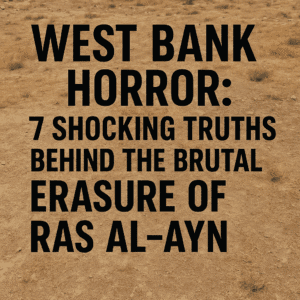The sun-baked hills of Ras al-Ayn in the occupied West Bank tell a story not of ancient history, but of a present-day displacement unfolding in real time. For families like Salaam Ka’abneh’s, who have tended this land for over half a century, life has become a relentless siege. “We face daily assaults, day and night,” Ka’abneh states, his voice heavy with exhaustion. “They terrorise our children and women, throwing stones, firing bullets, and creating chaos.” The “they” are Israeli settlers, emboldened and increasingly aggressive, their goal, according to activists on the ground, is simple: to force Palestinians out.
This isn’t just a land dispute; it’s the systematic dismantling of a community.
Footage captured by groups like ‘Looking the Occupation in the Eye’ reveals the tactics: settlers swarming village centers, armed individuals driving freely through Palestinian areas, and the strategic severing of life-sustaining resources. Ka’abneh recounts the theft of over 2,000 sheep and the deliberate cutting off of water access and grazing land. “We are under siege,” he says. “Our sheep remain caged.”
The Shadow of Impunity:
While the Israeli military officially governs Area C, where Ras al-Ayn lies, human rights organizations report a consistent, chilling pattern: settler violence operates with near-total impunity.
“Israel doesn’t hold settlers accountable,” asserts Sarit Michaeli of the Israeli group B’Tselem. “Settlers know that if they act violently, they’ll receive support… There’s full impunity. In fact, it’s more accurate to say settlers function as a branch of the government.”
Michaeli pulls no punches in describing the outcome: “It’s daylight robbery of land – sanctioned by Israeli authorities. And it amounts to ethnic cleansing – displacing large parts of the Palestinian population to make the area available for Israeli use.”
A Movement Cementing Facts on the Ground:
This escalation occurs against a backdrop of official Israeli plans to establish 22 new settlements in the West Bank, legalizing existing outposts built without authorization. The settler movement, born after Israel captured the territory in 1967, has grown from scattered outposts into established towns with state infrastructure and security. Today, 700,000 settlers live in the West Bank and East Jerusalem – communities widely considered illegal under international law, a status Israel disputes.
The rhetoric from settler leadership is uncompromising. Daniella Weiss, a prominent figure recently sanctioned by the UK, declares: “There will never be a Palestinian state between the Jordan River and the Mediterranean. Never. We annex with facts on the ground. The goal is to block any possibility… If Netanyahu wanted to stop me, he could.”
The Human Cost of Annexation:
Attempts to engage with the settlers overlooking Ras al-Ayn resulted only in hostile confrontation, a microcosm of the fear permeating Palestinian communities. The impact extends far beyond individual acts of violence. Palestinian land is rapidly disappearing – consumed by settlements, declared military zones, and rogue outposts. Each dunum taken shrinks the physical space and extinguishes the hope for a viable Palestinian future.
The Unseen Front:
While global attention often focuses on Gaza, Ras al-Ayn represents a critical, quieter front. It’s a struggle not just for land, but for existence. It’s the story of families rooted for generations, now facing a calculated campaign of terror and resource denial, facilitated by a system offering no protection and little recourse. The question echoing through the olive groves and barren pastures is not if more communities will be pushed out, but how the world will respond to this methodical erasure happening in plain sight. The annexation isn’t merely declared; it’s being violently, deliberately constructed, one terrified family and one stolen spring at a time.

You must be logged in to post a comment.